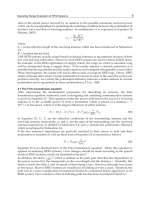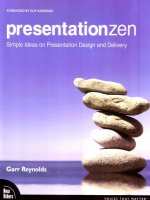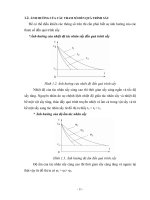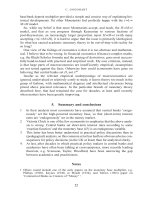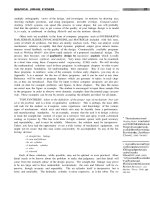presentation zen Simple ideas on presentation design and delivery phần 2 potx
Bạn đang xem bản rút gọn của tài liệu. Xem và tải ngay bản đầy đủ của tài liệu tại đây (1.58 MB, 24 trang )
The six aptitudes are: design, story, symphony, empathy, play, and meaning.
Mastering them is not sufficient, but leveraging these aptitudes has now become
necessary for professional success and personal fulfillment in today's world. The
introduction of the aptitudes that follow on the next page is written with
multimedia-enhanced presentations in mind, but you could take the six aptitudes
and apply them to the art of game design, programming, product design, project
management, health care, teaching, retail, and so on. The slide below summarizes
six of the key points found in Dan Pink's book. (Original images in the slide are
from a vector file
from iStockphoto.com
, file no. 700018.)
Chapter I Presenting in Today's World 15
Design
To many business people, design is something you spread on the surface, like
icing on a cake. It's nice, but not mission-critical. But this is not design to me, but
rather "decoration." Decoration, for better or worse, is noticeable—sometimes
enjoyable, sometimes irritating, but it is unmistakably there. However, the best
designs are so well done that "the design" is never even noticed consciously by
the observer/user, such as the design of a book or signage in an airport. (For
example, we take conscious note of the messages which the design helped make
utterly clear, but not the color palette, typography, concept, etc.)
Design starts at the beginning, not at the end; it's not an afterthought. If you use
slideware in your presentation, the design of those visuals begins in the preparation
stage before you have even turned on your computer. During the preparation stage,
you slow down and "stop your busy mind" so that you may consider your topic and
your objectives, your key messages, and your audience. Only then will you begin to
sketch out ideas that will appear in some digital visual form later.
Story
Facts, information, data. Most of it is available online or can be sent to people in an
email, a PDF attachment, or a hard copy through snail mail. Data and "the facts"
have never been more widely available. Cognitive scientist Mark Turner calls
storytelling "narrative imagining," something that is a key instrument of thought. We
are wired to tell and receive stories. We are all born storytellers (and
"storylisteners"). As kids we looked forward to "show and tell," and we gathered
with our friends at recess and at lunchtime and told stories about real things and real
events that mattered, at least they mattered to us.
But somewhere along the line, "story" became synonymous with fiction or even
falsehood. So story and storytelling have been marginalized in business and
academia as something serious people do not engage in. But gathering from what
college students tell me, the best and most effective professors are the ones who
tell true stories. My students tell me that the best professors (from their point of
view) don't just go through the material in a book, but put their own personality,
character, and experiences into the material in the form of a narrative, which is
illuminating, engaging, and memorable. Stories can be used for good: for teaching,
for sharing, for illuminating, and of course, for honest persuasion.
16 Presentation Zen
Symphony
Focus, specialization, and analysis have been important in the "information age,"
but in the "conceptual age," synthesis and the ability to use seemingly unrelated
pieces to form and articulate the big picture before us is crucial, even a
differentiator. Pink calls this aptitude "symphony."
The best presenters can illuminate the relationships that we may not have seen
before. They can "see the relationships between relationships." Symphony requires
that we become better at seeing—truly seeing in a new way. Anyone can deliver
chunks of information and repeat findings represented visually in bullet points on a
screen, but what's needed are those who can recognize the patterns, and who are
skilled at seeing nuances and the simplicity that may exist in a complex problem.
Symphony in the world of presentation does not mean "dumbing down"
information into sound bytes and talking points so popular in the mass media, for
example. Symphony is about utilizing our whole mind—logic, analysis, synthesis,
intuition—to make sense of our world (i.e., our topic), find the big picture, and
determine what is important and what is not before the day of our talk. It's also
about deciding what matters and letting go of the rest.
Empathy
Empathy is emotional. It's about putting yourself in the position of others. It involves
an understanding of the importance of the nonverbal cues of others and being
aware of your own. Good designers, for example, have the ability to put themselves
in the position of the user, the customer, or the audience member. This is a talent,
perhaps, more than it's a skill that can be taught, but everyone can get better at this.
Empathy allows a presenter, even without thinking about it, to notice when the
audience is "getting it" and when they are not. The empathetic presenter can make
adjustments based on his reading of this particular audience.
Chapter I Presenting in Today's World 17
Play
In the conceptual age, says Pink, work is not just about seriousness but about play as
well. Each presentation situation is different, but in many public speaking situations
playfulness and humor can go a long way toward making a presentation palatable.
"Humor" does not imply "jokiness" or clown-like informality, but rather good, old-
fashioned humor that leads to laughter. Indian physician Madan Kataria points out in
Pink's book that many people think that serious people are the best suited for
business, that serious people are more responsible. "[But] that's not true," says
Kataria. "That's yesterday's news. Laughing people are more creative people. They
are more productive people." Somewhere along the line, we were sold the idea that
a real business presentation must necessarily be dull, devoid of humor, and
something to be endured, not enjoyed. And if you use slides—and God help you if
you don't—the more complex, detailed, and ugly the better. This approach is still
alive and well today, but we can hope in the future that this too will become
"yesterday's news."
Satirist Tom Rielly gets
playful in his 2007 TED
presentation. TED/
leslieimage.com
18 Presentation Zen
Meaning
I don't want to put too fine a point on this, but making a presentation is an
opportunity to make a small difference in the world (or your community, or your
company, or school, etc.). A presentation that goes badly can have a devastating
impact on your spirit and on your career. But a presentation that goes well can be
extremely fulfilling for both you and the audience, and it might even help your
career. Some say that we "are born for meaning" and live for self-expression and an
opportunity to share that which we feel is important. If you are lucky, you're in a job
that you feel passionate about. If so, then it's with excitement that you look forward
to the possibility of sharing your expertise—your story—with others. Few things can
be more rewarding than connecting with someone by teaching something new, or
sharing that which you feel is very important with others.
Audiences are so used to death-by-PowerPoint that they've seemingly learned to
see it as normal, even if not ideal. However, if you are different—if you exceed
expectations and show them that you've thought about them, done your homework
and know your material, and demonstrated through your actions how much you
appreciate being there and that you are there for them—chances are you'll make an
impact and a difference, even if it's just in the smallest of ways. There can be great
meaning in even these small connections.
Design. Story. Symphony. Empathy. Play. Meaning. Dan Pink's A Whole New Mind
gives us the context of the new world we're living in and why "high touch" talents—
and that includes exc
eptional presentation skills—are so important today.
Professionals today around the globe need to understand how and why the so-
called right-brain aptitudes of design, story, symphony, empathy, play, and meaning
are more important than ever. The best presentations of our generation will be
created by professionals—engineers as well as CEOs and "creatives"—who have
strong "whole mind" aptitudes and talents. These are not the only aptitudes needed
by the modern presenter, but mastering these talents along with other important
abilities such as strong analytical skills will take you far as a communicator in the
"conceptual age."
Chapter I Presenting in Today's World 19
Seth Godin
Speaker, blogger, author of
Meatball Sundae
www.sethgodin.com
Marketing guru and presenter extraordinaire
Seth Godin says presentation is about the
transfer of emotion.
It doesn't matter whether you're trying to
champion at a church or a school or a Fortune
100 company, you're probably going to use
PowerPoint. PowerPoint was developed by
engineers as a tool to help them communicate
with the marketing department—and vice
versa. It's a remarkable tool because it allows
very dense verbal communication. Yes, you
could send a memo, but no one reads
anymore. As our companies are getting faster
and faster, we need a way to communicate
ideas from one group to another. Enter
PowerPoint.
PowerPoint could be the most powerful tool
on your computer. But it's not. Countless
innovations fail because their champions use
PowerPoint the way Microsoft wants them to,
instead of the right way.
Communication is about getting others to
adopt your point of view, to help them
understand why you're excited (or sad, or
optimistic or whatever else you are.) If all you
want to do is create a file of facts and figures,
then cancel the meeting and send in a report.
Our brains have two sides. The right side is
emotional, musical and moody. The left side is
focused on dexterity, facts and hard data.
When you show up to give a presentation,
people want to use both parts of their brain.
So they use the right side to judge the way you
talk, the way you dress and your body
language. Often, people come to a conclusion
about your presentation by the time you're on
the second slide. After that, it's often too late
for your bullet points to do you much good.
You can wreck a communicationprocess with
lousy logic or unsupported facts, but you can't
complete it without emotion. Logic is not
enough. Communication is the transfer of
emotion.
Champions must sell—to internal audiences
and to the outside world. If everyone in the
room agreed with you, you wouldn't need to
do a presentation, would you? You could save
a lot of time by printing out a one-page
project report and delivering it to each person.
No, the reason we do presentations is to make
a point, to sell one or more ideas.
If you believe in your idea, sell it. Make
your point as hard as you can and get what
you came for. Your audience will thank you
for it, because deep down, we all want to be
sold.
How to improve immediately
First, make slides that reinforce your words,
not repeat them. Create slides that
demonstrate, with emotional proof, that what
you're saying is true not just accurate. No more
than six words on a slide. EVER. There is no
presentation so complex that this rule needs to
be broken.
Second, don't use cheesy images. Use
professional stock photo images. Talking
about pollution in Houston? Instead of giving
me four bullet points of EPA data, why not
read me the stats but show me a photo of a
bunch of dead birds, some smog and even a
diseased lung? This is cheating! It's unfair! It
works.
Third, no dissolves, spins or other
transitions. Keep it simple.
Fourth, create a written document. A leave-
behind. Put in as many footnotes or details
as you like. Then, when you start your
presentation, tell the audience that you're
going to give them all the details of your
presentation after it's over, and they don't
have to write down everything you say.
Remember, the presentation is to make an
emotional sale. The document is the proof
that helps the intellectuals in your audience
accept the idea that you've sold them on
emotionally. Don't hand out printouts of your
slides. They don't work without you there.
The home run is easy to describe: You put up
a slide. It triggers an emotional reaction in the
audience. They sit up and want to know what
you're going to say that fits in with that image.
Then, if you do it right, every time they think of
what you said, they'll see the image (and vice
versa). Sure, this is different from the way
everyone else does it. But everyone else is
busy defending the status quo (which is easy)
and you're busy championing brave new
innovations, which is difficult.
A New Era Requires New Thinking
The skills necessary to be an effective communicator today are different than in the
past. Today, literacy is not only about reading and writing text (though that is just as
necessary), but also about understanding visual communication. Today, we need a
higher degree of visual literacy and an understanding of the great power that
imagery has for conveying important messages.
People who design visuals and use them in a live presentation typically regard
PowerPoint as a kind of document-creation tool. Their principles and techniques
seem to be largely influenced by conventional wisdom regarding the proper
creation of business documents, such as letters, reports, spreadsheets, and so on.
Many business people and students approach multimedia slides as if they were
nothing more than glorified overhead transparencies that contain boxes for text,
bullets, and some clip art.
If you want to learn how to become a better presenter, then look beyond the
advice given in books about how to use PowerPoint or books on presentation skills
(including this one). These books have their place, but you should be looking to
other forms of proven, visual storytelling as well. Documentary films, for example,
are a medium that tells a non-fiction story incorporating narration, interviews, audio,
powerful video and still images, and at times, on-screen text. These are elements
that can be incorporated into a live oral presentation as well. Cinema and
presentations are different, but not as different as you may think. I have learned
much about the use of imagery in storytelling from watching virtually every Ken
Burns documentary ever produced.
The art of comics is another place to look for knowledge and inspiration. Comics,
for example, are amazingly effective at partnering text and images that together
form a powerful narrative which is engaging and memorable.
Comics and film are the two major ways that stories are told through imagery. A
key point to remember is that the principles and techniques for creating a
presentation for a conference or a keynote address have more in common with the
principles and techniques behind the creation of a good documentary film or a
good comic book than the creation of a conventional static business document with
bullet points.
22 Presentation Zen
Letting Go
Part of the Presentation Zen approach to presenting well is learning to give up what
we've learned about making presentations in the era of the PowerPoint deck and
the cookie-cutter method of design and delivery. The first step is to stop letting our
history and conditioning about what we ''know" (or thought we knew) inhibit our
being open to other ways of presentation. Seven sentences per slide? Some clip art
thrown in for good measure? No one ever got fired for that, right? But if we remain
attached to our past, we cannot learn anything new. We must open our minds so
that we can see the world for what it is with a fresh new perspective.
Chapter I Presenting in Today's World 23
24 Presentation Zen
EXERCISE
Either alone or with your work group or team, have a brainstorming session
where you examine your current views and guidelines (if you have them)
concerning your organization's presentations. How are your current
presentations out of kilter? In what ways are they in sync? What questions
should you be asking about presentation design and delivery that you have
not asked in the past? What aspects of the design and delivery process have
caused "suffering" for your presenters and your audiences? Have past efforts
been focused too much on the comparatively inconsequential things? What
are the "inconsequential" aspects and where can the focus shift?
In Sum
Like a Japanese bento, great slide presentations contain
appropriate content arranged in the most efficient, graceful
manner without superfluous decoration. The presentation of the
content is simple, balanced, and beautiful.
Presentation Zen is an approach, not an inflexible list of rules to
be followed by all
the same way. There are many paths to
designing and delivering presentations.
The "Death by PowerPoint" approach is common and
"normal" but i
t is not effective. The problem is not one of
tools or technique so much as it is a problem of bad habits.
Though some tools are better than others, it is possible to
present effectively even with older versions of PowerPoint (or
Keynote, etc.).
In the "conceptual age" solid presentation skills are more
important now
than ever before. Presenting well is a "whole
minded" skill. Good presenters target people's "left brain" and
"right brain."
Live talks enhanced by multimedia are about storytelling and
have more in comm
on with the art of documentary film than the
reading of a paper document. Live talks today must tell a story
enhanced by imagery and other forms of appropriate
multimedia.
We've learned some ineffective habits over the years. The first
step to change
is letting go of the past.
Chapter I Presenting in Today's World 25
Such power there is in clear-
eyed self-restraint.
- James Russel
Creativity, Limitations,
and Constraints
In Chapter 3, we'll look at the first steps in the preparation stage, but first
let's take a step back and look at something we usually do not think about
when preparing a presentation: creativity. You may not think of yourself
as being creative, let alone one of the creative professionals such as
designers, writers, artists, and so on. But developing presentation
content—especially content to be delivered with the aid of multimedia—is
a creative act.
Recently, I gave a talk to college students where I encouraged them—
begged them—to remember that they were, in fact, creative beings
(they're human aren't they?). When I asked for a show of hands, most
said they were not particularly creative. After all, they said, they were not
designers or artists; they were business students. Then I asked them if
they thought creating and delivering a business or conference
presentation was a creative endeavor or something requiring a creative
process. Only a few felt that it was. How about "design thinking?" Even
fewer students understood how that related to a typical business
presentation. "Design as differentiator?" Sure, students got that. But
what, they said, did that have to do with presentations? Design was
about iPods, and espresso machines, and sports cars, they said, but not
about presentations and certainly "not PowerPoint."
Creating presentations is a supremely creative process. At least it should
be. It's as much "right brain" as it is "left brain," and design does matter.
Who said that business and creativity were mutually exclusive? Is
business only about managing numbers and administration? Can't
students become better business leaders tomorrow by learning how to
become better design thinkers today? Aren't "design thinking" or "design
mindfulness" and "creative thinking"
Chapter 2 Creativity, Limitations, and Constraints 31
valuable aptitudes for all professionals,
regardless of their discipline or their particular
task at hand?
Once you realize that the preparation of a
presentation is an act requiring creativity, not
merely the assembling of facts and data in a
linear fashion, you'll see that preparing a
presentation is a "whole-minded" activity that
requires as much right-brain thinking as it
does left-brain thinking. In fact, while your
research and background work may have
required much logical analysis, calculation,
and careful evidence gathering or so-called
left-brain thinking, the transformation of your
content into presentation form will require that
you exercise much more of your so-called
right brain.
32 Presentation Zen
Start With the Beginner's Mind
Zen teachings often speak of the "beginner's mind" or "child's mind." Like
a child, one who approaches life with a beginner's mind is fresh,
enthusiastic, and open to the vast possibilities of ideas and solutions
before them. A child does not know what is not possible and so is open to
exploration, discovery, and experimentation. If you approach creative
tasks with the beginner's mind, you can see things more clearly as they
are, unburdened by your fixed view, habits, or what conventional wisdom
says it is (or should be). One who possesses a beginner's mind is not
burdened by old habits or obsessed about "the way things are done
around here" or with the way things could have or should have been done.
A beginner is open and receptive and is more inclined to say "why not?" or
"let's give it a shot," rather than "it's never been done" or "that's not
common."
When you approach a new challenge as a true beginner (even if you are
a seasoned adult), you need not be saddled with fear of failure or of
making mistakes. If you approach problems with the "expert's mind," you
are often blind to the possibilities. Your expert's mind is bound by the past
and is not interested in the new and different and un-tried. Your expert's
mind will say it can't be done (or shouldn't be done). Your beginner's mind
will say, "I wonder if this can be done?"
If you approach a task with the beginner's mind, you are not afraid of
being wrong. The fear of making a mistake, of risking an error, or of being
told you are wrong is constantly with us. And that's a shame. Making
mistakes is not the same thing as being creative, but if you are not willing
to make mistakes, then it is impossible to be truly creative. If your state of
mind is coming from a place of fear and risk avoidance, then you will
always settle for the safe solutions the solutions already applied many
times before. Sometimes, the "path already taken" is the best solution. But
you should not follow the path automatically without first seeing it for what it
really is. When you are open to possibilities, you may find that the common
way is the best way for your particular case. However, this will be a choice
you made not by habit, but by reflection and in the spirit of a fresh beginner
with fresh eyes and a new perspective.
Chapter 2 Creativity, Limitations, and Constraints 33
Children are naturally creative, playful, and experimental. If you ask me,
we were the most human when we were young kids. We "worked" on our
art, sometimes for hours at a time without a break, because it was in us,
though we didn't intellectualize it. As we got older, fears crept in, and
doubts, and self-censoring, and over-thinking. The creative spirit is in us
now; it's who we are. We just need to look at the kids around us to be
reminded of that. And whether you are 28 or 88 today, it's never too late,
because the child is still in you.
"In the beginner's mind there are many possibilities, in the expert's
mind there are few."
—Shunryu Suzuki
34 Presentation Zen
You Are Creative
Creative power or creative imagination is not only for the artists of the
world," t
he painters, the sculptors, and so on—teachers also need the
power of creativity. So do programmers, engineers, scientists, etc. You can
see the application of creative genius in many professional fields.
Remember, for example, that it was a group of brilliant and geeky-to-the-
core, left-brain NASA engineers on the ground who in 1970 was able to
jury-rig a solution to the life-threatening buildup of carbon dioxide in the
damaged Apollo 13 spacecraft. Their heroic fix—literally involving duct tape
and spare parts—was ingenious improvisation, it was imaginative, and it
was creative.
Being creative does not mean wearing black turtlenecks and hanging out
in jazz cafes sipping cappuccinos—it means using your whole mind to find
solutions. Creativity means not being paralyzed by your methods and
knowledge, but being able to think outside the box (sometimes very
quickly) to find solutions to unforeseen problems. This kind of situation
requires logic and analysis, but also big-picture thinking. And big-picture
thinking is a right-brain, creative aptitude.
Back down here on earth, the seemingly mundane business of a
conference presentation, designed and delivered with the help of
slideware, can be a very creative thing. A presentation is an opportunity to
differentiate yourself, or your organization, or your cause. It's your chance
to tell the story of why your content is important and why it matters. It can
be an opportunity to make a difference. So why look or talk like everyone
else? Why strive to meet expectations? Why not surpass expectations and
surprise people?
You are a creative person, probably far more creative than you think. All
people should work toward tapping into their creative abilities and
unleashing their imaginations.
If You Want to Write by Brenda Ueland (Graywolf Press) is one of the
m
ost inspiring and useful books I have ever read. The book was first
published in 1938 and probably should have been titled If You Want to Be
Creative." The simple yet sage advice will be of interest not only to writers
but also to anyone who yearns to be more creative in their work or to help
others get in touch with their creative souls (this goes for programmers and
epidemiologists, as well as designers and artists). This book should be
required reading for all professionals or people aspiring to teach anyone
Chapter 2 Creativity, Limitations, and Constraints 35
about anything. Below are ideas inspired by Brenda Ueland that you
should keep in mind when approaching the preparation of a presentation or
any other creative endeavor in your work.
The Big Lie
Ah, the big lie we tell ourselves: "I am not creative." Sure, you might not be
the next Picasso in your field (then again, who knows?). But it doesn't
matter. What matters is to not close yourself down too early in the process
of exploration. Failing is fine, necessary in fact. But avoiding
experimentation or risk—especially out of fear of what others may think—is
something that will gnaw at your gut more than any ephemeral failure. A
failure is in the past. It's done and over. In fact, it doesn't exist. But worrying
about "what might be if " or "what might have been if I had " are pieces of
baggage you carry around daily. They're heavy, and they'll kill your creative
spirit. Take chances and stretch yourself. You're only here on this planet
once, and for a very short time at that. Why not just see how gifted you are?
You may surprise someone. Most importantly, you may surprise yourself.
Image in this slide is of Sir Ken Robinson presenting
at TED in 2006. Original photo courtesy of TED/
leslieimage.com
.
36 Presentation Zen
Be a Pirate!
Inspiration. Where can you find it? A million places and in a million ways,
but probably not by doing the same old routine, or by gossiping with staff in
the break room about things that don't really matter. Sometimes, you can
find inspiration in teaching. When you teach someone something important
to you, you are reminded of why it matters, and the enthusiasm of the
student—child or adult—is infectious and can energize you. Ueland says: "I
helped them by trying to make them feel freer, bolder. Let her go! Be
careless, reckless! Be a lion. Be a pirate!" You know it's important to be
free, free like children are. You just need reminding occasionally.
Do Not Force It
Idling or doing nothing is important. Most of us, myself included, are
obsessed with getting things done. We're afraid to be unproductive. And
yet, the big ideas often come to you during your periods of "laziness,"
during those episodes of "wasting time." People need more time away from
the direct challenges of work. Long walks on the beach, a jog through the
forest, a bike ride, spending four to five hours in a coffee shop with the
Sunday paper. During these times, your creative spirit is energized.
Sometimes you need solitude and a break for slowing down so that you
may see things differently. Managers who understand this and give their
staff the time they need (which they can only do by genuinely trusting them)
are the secure managers, and the best managers.
Enthusiasm
Put your love, passion, imagination, and spirit behind it. Without
enthusiasm, there is no creativity. It may be a quiet enthusiasm, or it may
be loud. It doesn't matter, so long as it is real. I remember once a guy
commenting on a successful long-term project I did. He said to me, "Well,
you have enthusiasm, I'll give you that " It was a backhanded compliment.
These are the people who get us down. Life is short. Don't hang out with
people who dismiss the idea of enthusiasm, or worse still, with those who
try to kill yours. Trying to impress others or worrying about what others may
think of your enthusiasm or passion should be the last thing on your mind.
Chapter 2 Creativity, Limitations, and Constraints 37
When forced to work within a strict
framework the imagination is taxed to
its utmost – and will produced its
richest ideas. Given total freedom the
work is likely to be sprawled
- T. S. Eliot
38 Presentation Zen
The Art of Working With
Restrictions
My friends at Universal Studios Japan—Jasper von Meerheimb, Senior Art
Director, and Sachiko Kawamura, Senior Environmental Graphic
Designer—gave an excellent presentation recently for Design Matters
Japan on the issue of how restrictive conditions put on creative projects can
lead to inventive solutions. In their presentation, they talked about how to
develop concepts and implement them under such constraints as limited
time, space, and budget. For professional designers, creating great work
under a thousand constraints and limitations imposed from the outside is
simply the way the world of design works. Whether constraints are good or
bad, enabling or crippling, is in a sense irrelevant; constraints are simply the
way of the world. Still, as John Maeda points out in The Laws of Simplicity
(MIT Press) "In the field of design there is the belief that with more
constraints,
better solutions are revealed." Time, for example, and the
sense of urgency that it brings, is almost always a constraint, yet "urgency
and the creative spirit go hand in hand ," Maeda says.
Using creativity and skill to solve a problem or design a message among
a plethora of restrictions from the client, from the boss, and so on, is old hat
to designers. They live it. Daily. However, for the millions of nondesigners
with access to powerful design tools, the power and importance of
constraints and limitations is not well understood. For those not trained in
design, the task of creating presentation visuals (or posters, Web sites,
newsletters, etc.) with today's software tools can make one either frustrated
by the abundance of options or giddy in anticipation of applying their artistic
sensibilities to decorate their work with an ever-increasing array of color,
shapes, and special effects. Either condition can lead to designs and
messages that suffer. What you can learn from professional designers is
that (1) constraints and limitations are a powerful ally, not an enemy, and
(2) creating your own self-imposed constraints, limitations, and parameters
is often fundamental to good, creative work.
Self-imposed constraints can help you formulate clearer messages,
including
Chapter 2 Creativity, Limitations, and Constraints 39
